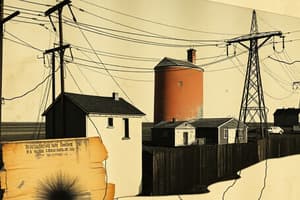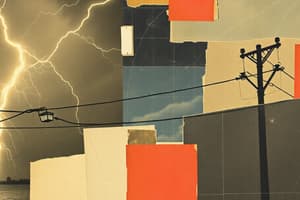Podcast
Questions and Answers
How does the gold leaf electroscope indicate the presence of electric charge?
How does the gold leaf electroscope indicate the presence of electric charge?
The gold leaves spread apart when the presence of electric charge induces a similar charge in them, causing them to repel each other.
What happens to the gold leaves in an electroscope when a positively charged object is brought close?
What happens to the gold leaves in an electroscope when a positively charged object is brought close?
Electrons are attracted from the leaves to the positively charged object, making the leaves positively charged, which causes them to repel each other.
What is lightning, and what causes it to occur?
What is lightning, and what causes it to occur?
Lightning is a sudden electrostatic discharge that occurs during thunderstorms, creating a bright flash of light and thunder.
List two safety measures to take during a lightning storm.
List two safety measures to take during a lightning storm.
What is the function of a lightning conductor?
What is the function of a lightning conductor?
What is the primary difference between Direct Current (D.C.) and Alternating Current (A.C.)?
What is the primary difference between Direct Current (D.C.) and Alternating Current (A.C.)?
List two sources of electricity mentioned in the content.
List two sources of electricity mentioned in the content.
How is electrical energy consumed measured in a circuit?
How is electrical energy consumed measured in a circuit?
What role does the Earth (or Ground) Wire play in electrical circuits?
What role does the Earth (or Ground) Wire play in electrical circuits?
Define the term 'kilowatt-hour' in the context of electrical energy.
Define the term 'kilowatt-hour' in the context of electrical energy.
What colors are typically used for the Live (or Phase) Wire and the Neutral Wire?
What colors are typically used for the Live (or Phase) Wire and the Neutral Wire?
What does the term 'Household electricity' refer to?
What does the term 'Household electricity' refer to?
Why is it important to understand the voltage, current, and time associated with electrical energy consumption?
Why is it important to understand the voltage, current, and time associated with electrical energy consumption?
Why should ordinary copper wire not be used as fuse wire?
Why should ordinary copper wire not be used as fuse wire?
Describe the process through which static electricity is generated.
Describe the process through which static electricity is generated.
What happens to two charged objects that have like charges?
What happens to two charged objects that have like charges?
Explain the difference between conductors and insulators.
Explain the difference between conductors and insulators.
What is charging by conduction?
What is charging by conduction?
Define charging by induction.
Define charging by induction.
What is the purpose of an electroscope?
What is the purpose of an electroscope?
How does a gold leaf electroscope function?
How does a gold leaf electroscope function?
How is energy consumption calculated and what is the energy consumed by a 100-watt bulb used for 10 hours?
How is energy consumption calculated and what is the energy consumed by a 100-watt bulb used for 10 hours?
What are the two main types of electric meters, and what is their purpose?
What are the two main types of electric meters, and what is their purpose?
Describe the function of an electric fuse in an electrical circuit.
Describe the function of an electric fuse in an electrical circuit.
What distinguishes a Miniature Circuit Breaker (MCB) from a traditional fuse?
What distinguishes a Miniature Circuit Breaker (MCB) from a traditional fuse?
Explain the difference between series circuits and parallel circuits.
Explain the difference between series circuits and parallel circuits.
What are some hazards associated with overloaded household electrical circuits?
What are some hazards associated with overloaded household electrical circuits?
List two precautions you should take to ensure electrical safety in your home.
List two precautions you should take to ensure electrical safety in your home.
What is the importance of proper insulation of wires in household electrical circuits?
What is the importance of proper insulation of wires in household electrical circuits?
Flashcards
Household Electricity
Household Electricity
The electrical power supplied to homes for various purposes like lighting, heating, and powering appliances.
Direct Current (DC)
Direct Current (DC)
A type of electrical current where the direction of flow remains constant over time. Examples include cells and batteries.
Alternating Current (AC)
Alternating Current (AC)
A type of electrical current where the direction and magnitude of flow changes periodically. Examples include the mains and electric generators.
Electrical Energy
Electrical Energy
Signup and view all the flashcards
Electrical Power
Electrical Power
Signup and view all the flashcards
Live Wire
Live Wire
Signup and view all the flashcards
Neutral Wire
Neutral Wire
Signup and view all the flashcards
Earth Wire
Earth Wire
Signup and view all the flashcards
Gold Leaf Electroscope
Gold Leaf Electroscope
Signup and view all the flashcards
Lightning
Lightning
Signup and view all the flashcards
Lightning Conductor
Lightning Conductor
Signup and view all the flashcards
Static Electricity
Static Electricity
Signup and view all the flashcards
Conductors
Conductors
Signup and view all the flashcards
Insulators
Insulators
Signup and view all the flashcards
Charging by Conduction
Charging by Conduction
Signup and view all the flashcards
Charging by Induction
Charging by Induction
Signup and view all the flashcards
Electroscope
Electroscope
Signup and view all the flashcards
Conservation of Charge
Conservation of Charge
Signup and view all the flashcards
Energy Calculation (kWh)
Energy Calculation (kWh)
Signup and view all the flashcards
What does an electric meter do?
What does an electric meter do?
Signup and view all the flashcards
Electric Fuse
Electric Fuse
Signup and view all the flashcards
Miniature Circuit Breaker (MCB)
Miniature Circuit Breaker (MCB)
Signup and view all the flashcards
What are household electrical circuits?
What are household electrical circuits?
Signup and view all the flashcards
Series Circuit
Series Circuit
Signup and view all the flashcards
Parallel Circuit
Parallel Circuit
Signup and view all the flashcards
Hazards of Electricity
Hazards of Electricity
Signup and view all the flashcards
Study Notes
Electricity
- Household electricity refers to the electrical power supplied to homes needed for various domestic purposes, including lighting, heating, and appliances. It's delivered through an alternating current (AC) network.
Types of Current
- Direct Current (DC): Current remains constant over time. Examples include cells and batteries.
- Alternating Current (AC): Current's magnitude and polarity change over time. Examples include mains electricity and generators.
Sources of Electricity
- Electric cells and batteries
- Mains supply (local electricity board)
- Generators (or dynamos)
- Solar cells
Electrical Energy and Power
- Electrical energy is the energy transferred by electric current.
- The amount of energy consumed depends on voltage, current, and time.
- Measured in joules (J) or kilowatt-hours (kWh).
Colour Coding of Wires
- Live/Phase: Typically red or brown, carries current from the power source to the appliance.
- Neutral: Typically black or blue, completes the circuit by carrying the current back to the power source.
- Earth/Ground: Typically green or yellow-green striped, provides a safe path to the ground, preventing electric shocks.
Commercial Unit of Electrical Energy
- Kilowatt-hour (kWh) is the standard unit.
- Used to measure and bill for energy consumption by electricity providers.
Electric Meter
- Measures electrical energy consumed.
- Types include analog and digital meters.
- Crucial for billing household/business electricity usage.
Electric Fuse
- Safety device in electrical circuits.
- Protects against excessive current flow which can cause fires or damage appliances.
- Characteristics include a short wire with a low melting point and connected in series with live wire.
- Fuse wire thickness depends on its current rating.
Miniature Circuit Breaker (MCB)
- Automatic electrical switch.
- Designed to protect electrical circuits from overloads and short circuits.
Household Electrical Circuits
- Networks of wires, switches, outlets, and appliances.
- Deliver electricity to various parts of a home.
Circuit Types
- Series Circuit: Components connected sequentially. If one component fails, the entire circuit stops.
- Parallel Circuit: Components connected alongside each other. If one component fails, other components continue functioning independently.
Hazards of Electricity
- Overload causes short circuit
- Poor insulation causes short circuit or current flow issues.
- Electric shock by contact with live wire
Precautions to Take
- Do not touch switches with wet hands.
- Properly connect wires to plugs, sockets and switches.
- Ensure that appliances are properly earthed.
- Avoid repairing appliances while in use.
Static Electricity
- Accumulation of electric charge on the surface of an object.
- An imbalance of charges within or on the surface of a material.
- Charging by rubbing can occur.
- Like charges repel, unlike charges attract.
Conservation of Charge
- Before rubbing, objects have no charges.
- After rubbing, objects have equal and opposite charges.
Conductors and Insulators
- Conductors: Materials allowing easy current flow (due to free electrons). Examples are metals.
- Insulators: Materials resisting current flow (due to few free electrons). Examples are glass, rubber, plastic, wood.
Methods of Charging a Conductor
- Conduction: Charging by direct contact with a charged object.
- Induction: Charging without direct contact—charge in an object is induced by bringing a charged object near it.
Electroscope
- Simple device used to detect and measure electrical charge.
- Visual indication of charge presence and magnitude, often using gold leaves.
Lightning
- Powerful, natural electrostatic discharge during thunderstorms.
- Safety measures include not standing under trees or tall buildings, seeking shelter in low-lying areas, avoiding carrying umbrellas, and switching off electrical appliances.
- Lightning conductors help protect buildings by providing a safe path for the current to the ground.
Studying That Suits You
Use AI to generate personalized quizzes and flashcards to suit your learning preferences.




